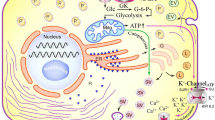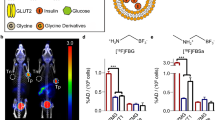Abstract
Androgen receptor (AR) mediates a wide range of cellular processes, such as proliferation, differentiation and apoptosis. Here we sought to identify whether AR was located in pancreatic beta-cells and investigate its functions in type 1 diabetes induced by multiple low doses of streptozotocin. Double/triple immunofluorescence, Western blot and semi-quantitative RT-PCR were carried out to determine variances of AR expression in beta-cells and correlation between AR and apoptosis/proliferation of beta-cells with progress of diabetes. In addition, in vitro primary beta-cells from control mice were cultured for 3 days or 6 days with compound stimulation in order to further identify effect of AR on beta-cell apoptosis and proliferation. AR expression in beta-cells peaked in control and 1-day diabetic mice, gradually and significantly decreased, even disappeared in diabetic mice with progress of diabetes. TUNEL-positive beta-cells were concomitant with overexpression of AR, and Ki67-positive beta-cells showed extremely weak, even negative AR staining. In vitro, AR could mediate beta-cell apoptosis, and AR antagonist flutamide contributed to beta-cell proliferation. In conclusion, AR is abundantly expressed in pancreatic beta-cell cytoplasm of control mice. With progress of type 1 diabetes, decrement of AR expression in diabetic mice contributes to prohibit beta-cells from apoptosis, and is strongly associated with beta-cell proliferation.












Similar content being viewed by others
References
Wierman ME (2007) Sex steroid effects at target tissues: mechanisms of action. Adv Physiol Educ 31:26–33. doi:10.1152/advan.00086.2006
Unni E, Sun S, Nan B et al (2004) Changes in androgen receptor nongenotropic signaling correlate with transition of LNCaP cells to androgen independence. Cancer Res 64:7156–7168. doi:10.1158/0008-5472.CAN-04-1121
Lin Y, Kokontis J, Tang F et al (2006) Androgen and its receptor promote Bax-mediated apoptosis. Mol Cell Biol 26:1908–1916. doi:10.1128/MCB.26.5.1908-1916.2006
Kampa M, Papakonstanti EA, Hatzoglou A et al (2002) The human prostate cancer cell line LNCaP bears functional membrane testosterone receptors that increase PSA secretion and modify actin cytoskeleton. FASEB J 16:1429–1431
Kang HY, Cho CL, Huang KL et al (2004) Nongenomic androgen activation of phosphatidylinositol 3-kinase/Akt signaling pathway in MC3T3-E1 osteoblasts. J Bone Miner Res 19:1181–1190. doi:10.1359/JBMR.040306
Nguyen TV, Yao M, Pike CJ (2005) Androgens activate mitogen-activated protein kinase signaling: role in neuroprotection. J Neurochem 94:1639–1651. doi:10.1111/j.1471-4159.2005.03318.x
Sun M, Yang L, Feldman RI et al (2003) Activation of phosphatidylinositol 3-kinase/Akt pathway by androgen through interaction of p85a, androgen receptor and Src. J Biol Chem 278:42992–43000. doi:10.1074/jbc.M306295200
Boonyaratanakornkit V, Edwards DP (2007) Receptor mechanisms mediating non-genomic actions of sex steroids. Semin Reprod Med 25:139–153. doi:10.1055/s-2007-973427
Roep BO (2003) The role of T-cells in the pathogenesis of Type 1 diabetes: from cause to cure. Diabetologia 46:305–321
Gombos Z, Hermann R, Veijola R et al (2003) Androgen receptor gene exon 1 CAG repeat polymorphism in Finnish patients with childhood-onset type 1 diabetes. Eur J Endocrinol 149:597–600. doi:10.1530/eje.0.1490597
Meyer K, Deutscher J, Anil M, Berthold A, Bartsch M, Kiess W (2000) Serum androgen levels in adolescents with type 1 diabetes: relationship to pubertal stage and metabolic control. J Endocrinol Invest 23:362–368
Gale EA, Gillespie KM (2001) Diabetes and gender. Diabetologia 44:3–15. doi:10.1007/s001250051573
Rees DA, Alcolado JC (2004) Animal models of diabetes mellitus. Diabet Med 22:359–370. doi:10.1111/j.1464-5491.2005.01499.x
Yang Z, Chen M, Fialkow LB et al (2003) The novel anti-inflammatory compound, lisofylline, prevents diabetes in multiple low-dose streptozotocin-treated mice. Pancreas 26:e99–e104. doi:10.1097/00006676-200305000-00021
Muller A, Schott-Ohly P, Dohle C et al (2002) Differential regulation of Th1-type and Th2-type cytokine profiles in pancreatic islet cells of C57/BL6 and BALB/c mice by multiple low doses of streptozotocin. Immunobiology 205:35–50. doi:10.1078/0171-2985-00109
Mensah-Brown EP, Stosic Grujicic S, Maksimovic D et al (2002) Downregulation of apoptosis in the target tissue prevents low-dose streptozotocin-induced autoimmune diabetes. Mol Immunol 38:941–946. doi:10.1016/S0161-5890(02)00021-4
Li RJ, Qiu SD, Chen HX et al (2007) The immunotherapeutic effects of Astragalus polysaccharide in type 1 diabetic mice. Biol Pharm Bull 30:470–476. doi:10.1248/bpb.30.470
Meier JJ, Bhushan A, Butler AE et al (2005) Sustained beta cell apoptosis in patients with long-standing type 1 diabetes: indirect evidence for islet regeneration? Diabetologia 28:2221–2228. doi:10.1007/s00125-005-1949-2
Paris M, Bernard-Kargar C, Berthault MF et al (2003) Specific and combined effects of insulin and glucose on functional pancreatic beta-cell mass in vivo in adult rats. Endocrinology 144:2717–2727. doi:10.1210/en.2002-221112
Smith PD, McLean KJ, Murphy MA et al (2005) A brightness-area-product-based protocol for the quantitative assessment of antigen abundance in fluorescent immunohistochemistry. Brain Res Brain Res Protoc 15:21–29. doi:10.1016/j.brainresprot.2005.02.004
Fuentes-Santamaría V, Alvarado JC, Henkel CK et al (2007) Cochlear ablation in adult ferrets results in changes in insulin-like growth factor-1 and synaptophysin immunostaining in the cochlear nucleus. Neuroscience 148:1033–1047. doi:10.1016/j.neuroscience.2007.07.026
Guo ZL, Moazzami AR, Longhurst JC (2005) Stimulation of cardiac sympathetic afferents activates glutamatergic neurons in the parabrachial nucleus: relation to neurons containing nNOS. Brain Res 1053:97–107. doi:10.1016/j.brainres.2005.06.051
Luo L, Badiavas E, Luo JZ et al (2007) Allogeneic bone marrow supports human islet beta cell survival and function over six months. Biochem Biophys Res Commun 361:859–864. doi:10.1016/j.bbrc.2007.07.105
Pipeleers DG, in’t Veld PA, Van de Winkel M et al (1985) A new in vitro model for the study of pancreatic A and B cells. Endocrinology 117:806–816
McCann JP, Mayes JS, Hendricks GR et al (2001) Subcellular distribution and glycosylation pattern of androgen receptor from sheep omental adipose tissue. J Endocrinol 169:587–593. doi:10.1677/joe.0.1690587
Parnaud G, Bosco D, Berney T et al (2008) Proliferation of sorted human and rat beta cells. Diabetologia 51:91–100. doi:10.1007/s00125-007-0855-1
Wiren KM, Toombs AR, Semirale AA et al (2006) Osteoblast and osteocyte apoptosis associated with androgen action in bone: requirement of increased Bax/Bcl-2 ratio. Bone 38:637–651. doi:10.1016/j.bone.2005.10.029
Ling S, Dai A, Williams MR et al (2002) Testosterone (T) enhances apoptosis-related damage in human vascular endothelial cells. Endocrinology 143:1119–1125. doi:10.1210/en.143.3.1119
Robertson RP, Harmon JS (2006) Diabetes, glucose toxicity, and oxidative stress: a case of double jeopardy for the pancreatic islet beta cell. Free Radic Biol Med 41:177–184. doi:10.1016/j.freeradbiomed.2005.04.030
Ueki K, Okada T, Hu J et al (2006) Total insulin and IGF-I resistance in pancreatic beta cells causes overt diabetes. Nat Genet 38:583–588. doi:10.1038/ng1787
Wu CT, Altuwaijri S, Ricke WA et al (2007) Increased prostate cell proliferation and loss of cell differentiation in mice lacking prostate epithelial androgen receptor. Proc Natl Acad Sci USA 104:12679–12684. doi:10.1073/pnas.0704940104
Haapala K, Kuukasjärvi T, Hyytinen E et al (2007) Androgen receptor amplification is associated with increased cell proliferation in prostate cancer. Hum Pathol 38:474–478. doi:10.1016/j.humpath.2006.09.008
Vander Griend DJ, Litvinov IV, Isaacs JT (2007) Stabilizing androgen receptor in mitosis inhibits prostate cancer proliferation. Cell Cycle 6:647–651
Arnold JT, Liu X, Allen JD et al (2007) Androgen receptor or estrogen receptor-beta blockade alters DHEA-, DHT-, and E(2)-induced proliferation and PSA production in human prostate cancer cells. Prostate 67:1152–1162. doi:10.1002/pros.20585
Tan KA, De Gendt K, Atanassova N et al (2005) The role of androgens in sertoli cell proliferation and functional maturation: studies in mice with total or Sertoli cell-selective ablation of the androgen receptor. Endocrinology 146:2674–2683
Pipeleers D, Hoorens A, Marichal-Pipeleers M et al (2001) Role of pancreatic beta-cells in the process of beta-cell death. Diabetes 50(Suppl 1):S52–S57
Acknowledgements
We thank Hai-Lin Teng for valuable discussion and critical review of the manuscript. We also acknowledge Research Foundation Grant (HW153) presented by Health Department of Shandong Province of China.
Author information
Authors and Affiliations
Corresponding author
Rights and permissions
About this article
Cite this article
Li, RJ., Qiu, SD., Wang, HX. et al. Androgen receptor: a new player associated with apoptosis and proliferation of pancreatic beta-cell in type 1 diabetes mellitus. Apoptosis 13, 959–971 (2008). https://doi.org/10.1007/s10495-008-0230-9
Published:
Issue Date:
DOI: https://doi.org/10.1007/s10495-008-0230-9




